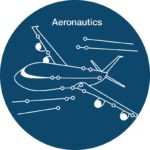 Aeronautics
Aeronautics
Demonstrate the full impact of the use of artificial intelligence in creating secure, safe, and trustable wireless aeronautical applications (secure tunnels and virtual links). This means literally to achieve a wireline-like performance for wireless services on board aircraft and in other aeronautical infrastructure (e.g. at smart airports). This will allow a massive replacement of cabling systems in modern infrastructure and the exploitation of new services (positioning, logistics management, security control, sensing, flow control, aircraft morphing, etc.). The aeronautics domain targets an improvement of 100 times spectral efficiency with modern wireless components, reduction to latency to less than 5ms end to end, and rejection of interreference of more than 30dB. This is expected to increase trust in stakeholders and decision makers of the industry;
InSecTT aims to be involved in international aeronautical sectors, regulation bodies, etc. to push for the use of AI and modern wireless components and thus boost the concept of fly-by- and manage-by-wireless.
The developments will also aim at the interaction of different levels of AI onboard the aircraft to control, monitor, commission, and manage different aspects of the wireline/wireless infrastructure, as well as different AI algorithms in different levels of the aeronautics industry (e.g. at airports). The aeronautics domain will also propose new methodologies for joint secure/safe/trust analysis and compliance of wireless components in alignment with aeronautical international safety, trust and cybersecurity standards.
InSecTT aims at demonstrating in economic value the advantage of using wireless technology with intelligence on board modern aircraft and in the evolution of several aeronautical infrastructure entities: airports, hangars, control operation towers, testing benches, aircraft manufacturing facilities, etc. The target is to increase TRL in different use cases at least one or two levels.
AI will help us learn from the propagation inside different aircraft, adapting to the changing conditions of different moments of a mission and different types of aircraft. Wireless technology on board can be used to detect aspects of turbulence, malfunctioning of elements, rotation and orientation correction of metallic parts of the aircraft, detection of formations on wings, sensing of fuel conditions, control and actuation over rotational or moving parts.
AI will help us organize context information and learn from the difficult conditions for wireless waves to propagate and adapt in a better way to a dynamic layer of radio (software-defined) parameters. The capacity of wireless transmission inside cabins or in airports will be boost and thus InSecTT will be able to demonstrate the wireline-like performance of wireless aeronautical networks. This is expected to have consequences in the aeronautics stakeholders, potentially looking at a demonstration in a representative environment inside an operational aircraft and/or in a live airport or hangar.
InSecTT aims to develop methodologies for testing and validating operational wireless modern technology in aeronautics. This will allow us to evaluate the use of artificial intelligence to create a set of trustable and highly critical or nearly deterministic pipes of information tunnels that can serve as a platform for highly secure and critical wireless aeronautical services. This methodology will be shared and disseminated with industrial partners in international trustiness and at the European and international standardisation level.
Aeronautical industry issues, in particular aircraft safety and airport secure management, are crucial aspects in future regional infrastructure cybersecurity. Customs control, passenger registration and privacy management, import/export control, etc are increasingly important aspects of national and international security. Multiple stakeholders, national authorities, civilian associations and health regulators are involved in the aeronautics infrastructure. A fully digitalized, trustable and flexible AI-wireless infrastructure will have a large impact in all these economic, social and political domains.
According to the ICAO, the number of passengers has reported an increase of nearly 8% in 2018 compared to 2017 reaching the figure of 4.1 billion. The increase in number of goods transported was nearly 10%. The use of AI-IoT wireless solutions aims to increase efficiency of flights, reduce fuel consumption, and improve management and operation in this industry. Reduction of fuel consumption can lead to cheaper fares to passengers and therefore an increase of flights and directly jobs related to the industry. New labour force will be required to adapt AI algorithms to the aeronautics infrastructure as well. Several million dollars are expected to be saved per aircraft in terms of planning of tasks and maintenance by the simple use of wireless solutions. AI can improve these figures by a good margin. While AI can replace labour force in aircraft design, it will increase it in terms of associated service labour force. If each aircraft cost is reduced by several million dollars, then end user fares can be reduced by 10-20%, which will increase the number of flights per year, transported goods and associated jobs to transportation services, cabin crew, pilots, AI engineers, etc.

